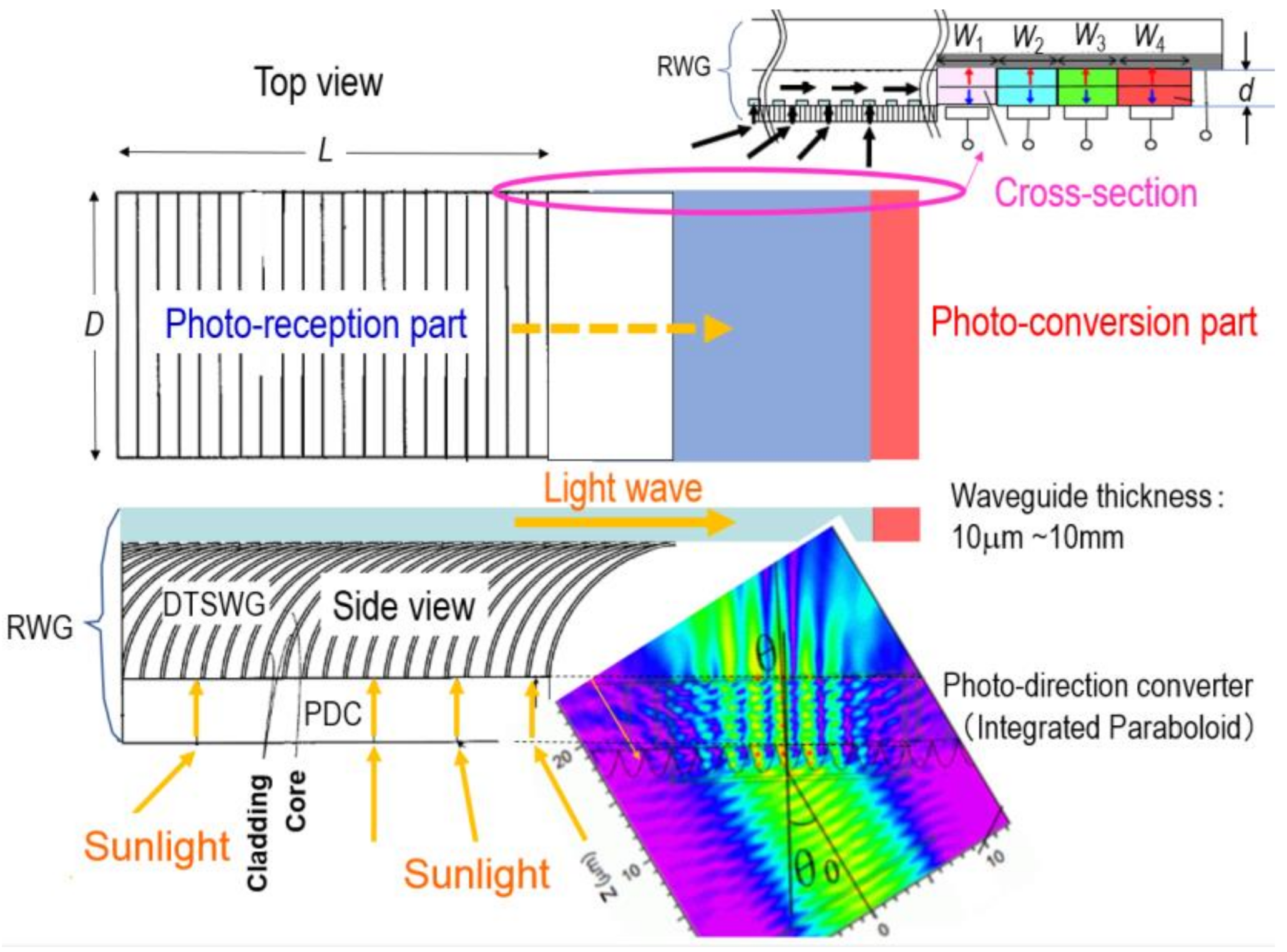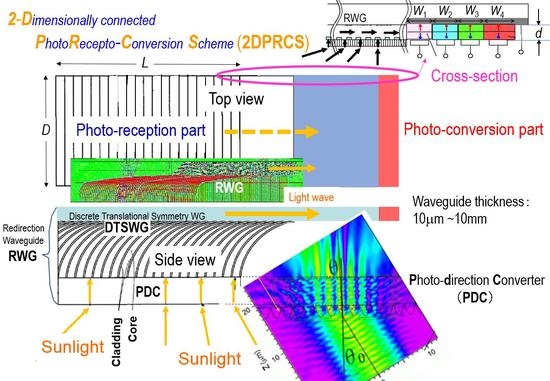Lifting Off Spatial Degeneracy of Functions, Where Does It Lead Us for Photovoltaic Device Systems?
Abstract
:1. Introduction
2. Two Dimensionally Connected Photoreceptor-Conversion Scheme
2.1. Photoharvesting (Photo-Reception) Part
2.1.1. Photopropagation Direction Convertor (PDC) in Redirection Waveguide (RWG)
2.1.2. The 3D-to-2D Conversion of Photons in Redirection Waveguide (RWG)
2.2. Photo-Electro-Conversion Part
2.2.1. Edge-Injection Configuration
2.2.2. Edge-Photoinjection Experiment
2.2.3. Limiting Conversion Efficiency Calculation
(for ∀j).
3. Discussion
4. Conclusions
Author Contributions
Funding
Acknowledgments
Conflicts of Interest
References
- Various Methods of Generating Electricity. Available online: https://www.rite.or.jp/system/en/learn-energy/energy-use/hatsuden/ (accessed on 31 August 2020).
- Solar Power Generation Costs in Japan: Current Status and Future Outlook. Available online: https://www.renewable-ei.org/pdfdownload/activities/Report_SolarPVCostJapan_EN.pdf (accessed on 31 August 2020).
- Green, M.A.; Dunlop, E.D.; Hohl-Ebinger, J.; Yoshita, M.; Kopidakis, N.; Ho-Baillie, A.W.Y. Solar cell efficiency tables (Version 55). Prog. Photovolt. Res. Appl. 2020, 28, 3–15. [Google Scholar] [CrossRef]
- Liu, M.; Jonson, M.B.; Snaith, H.J. Efficient planar heterojunction perovskite solar cells by vapour deposition. Nature 2013, 501, 395. [Google Scholar] [CrossRef] [PubMed]
- Suemori, K.; Miyata, T.; Hiramoto, M.; Yokoyama, M. Vertical Junction Type Organic Photovoltaic Cells. Jpn. J. Appl. Phys. 2004, 43, L1094. [Google Scholar] [CrossRef]
- Idemitsu. Available online: https://www.idss.co.jp/business/renewable/solar.html (accessed on 31 August 2020).
- Alpert, O. Long-Range Wireless Power Delivery by Infrared LightBeam—New Applications for Homes, Offices, Factories and Public Spaces. In Proceedings of the 1st Optical Wireless and Fiber Power Transmission Conference (OWPT2019), Yokohama, Japan, 23–25 April 2019. OWPT-1-02. [Google Scholar]
- Jenkins, P.P.; Scheiman, D.A.; Hoheisel, R.; Lorentzen, J.R.; Fischer, R.P.; Wayne, D.T.; Lynn, B.E.; Pogue, C.M.; Jaffe, P. Challenges in receiver design for free-space optical power transfer. In Proceedings of the Optical Wireless and Fiber Power Transmission Conference 2019 (OWPT 2019), Yokohama, Japan, 24 April 2019. OWPT-5-04. [Google Scholar]
- Masui, Y.; Bricker, D.; Vorontsov, M.A.; Weyrauch, T. Performance analysis of photovoltaic arrays for remote power beaming through the atmosphere. In Proceedings of the Optical Wireless and Fiber Power Transmission Conference 2019 (OWPT 2019), Yokohama, Japan, 25 April 2019. OWPT-9-02. [Google Scholar]
- Hildmann, H.; Kovacs, E. Using Unmanned Aerial Vehicles (UAVs) as Mobile Sensing Platforms (MSPs) for Disaster Response, Civil Security and Public Safety. Drones 2019, 3, 59. [Google Scholar] [CrossRef] [Green Version]
- Hament, B.; Oh, P. Unmanned aerial and ground vehicle (UAV-UGV) system prototype for civil infrastructure missions. In Proceedings of the 2018 IEEE International Conference on Consumer Electronics (ICCE), Las Vegas, NV, USA, 12–14 January 2018. [Google Scholar] [CrossRef]
- Li, G. Sun Trackers. Newscientist 2020, 246, 28–29. [Google Scholar] [CrossRef]
- Blanco, M.J.; Ramirez Santigosa, L.; Blanco, M.J. Advances in Concentrating Solar Thermal Research and Technology; Ramirez Santigosa, L., Ed.; Woodhead Publishing: Cambridge, UK, 2018. [Google Scholar]
- James Holloway. IBM’s Solar Tech Is 80% Efficient Thanks to Supercomputer Know-How. Available online: https://arstechnica.com/science/2013/04/ibms-solar-tech-is-80-efficient-thanks-to-supercomputer-know-how/ (accessed on 31 August 2020).
- Van Sark, W.G.J.H.M.; Barnham, K.W.J.; Slooff, L.H.; Chatten, A.J.; Büchtemann, A.; Meyer, A.; McCormack, S.J.; Koole, R.; Farrell, D.J.; Bose, R.; et al. Luminescent Solar Concentrators—A review of recent results. Opt. Express 2013, 16, 21773–21792. [Google Scholar] [CrossRef] [PubMed]
- Meinardi, F.; Ehrenberg, S.; Dhamo, L.; Carulli, F.; Mauri, M.; Bruni, F.; Simonutti, R.; Kortshagen, U.; Brovelli, S. Highly efficient luminescent solar concentratorsbased on earth-abundant indirect-bandgap siliconquantum dots. Nat. Photonics 2017, 11, 177–185. [Google Scholar] [CrossRef]
- Bergren, M.R.; Makarov, N.S.; Ramasamy, K.; Jackson, A.; Guglielmetti, R.; McDaniel, H. High-Performance CuInS2 Quantum Dot Laminated Glass Luminescent Solar Concentrators for Windows. ACS Energy Lett. 2018, 3, 520–525. [Google Scholar] [CrossRef]
- Ishibashi, A.; Sawamura, N. Two Dimensionally Connected Photorecepto-conversion Scheme (2DPRCS) for High Efficiency Solar Cells and Optical Wireless Power Transmission. In Proceedings of the 2nd Optical Wireless and Fiber Power Transmission Conference (OWPT 2020), Yokohama, Japan, 21–23 April 2020. [Google Scholar]
- The paraboloids sheets were provided by Yamagata, H. Impritecs Corporation, Japan.
- Ishibashi, A.; Okura, Y.; Sawamura, N. Towards a Planer Photon-harvesting Waveguide having Discrete Translational Symmetry with Open Core Geometry. In Proceedings of the 1st Optical Wireless and Fiber Power Transmission Conference (OWPT2019), Yokohama, Japan, 23–25 April 2019. OWPT-P-04. [Google Scholar]
- Ishibashi, A.; Kasai, T.; Sawamura, N. Redirection Waveguide having Discrete Translational Symmetry for Photovoltaic Systems with Solar-Cell Units Placed at the Periphery. Energies 2018, 11, 3498. [Google Scholar] [CrossRef] [Green Version]
- Ishibashi, A.; Kobayashi, H.; Sawamura, N.; Kondo, K.; Kasai, T. Symmetric and asymmetric waveguides for multi-striped orthogonal photon-photocarrier-propagation solar cells. In Proceedings of the 2017 International Conference on Applied System Innovation (ICASI), Sapporo, Japan, 13–17 May 2017; Meen, P., Meen, L., Eds.; IEEE-ICASI: New York, NY, USA, 2017; pp. 1477–1479. [Google Scholar]
- Ishibashi, A.; Kobayashi, H.; Taniguchi, T.; Kondo, K.; Kasai, T. Optical simulation for multi-striped orthogonal photon-photocarrier-propagation solar cell (MOP3SC) with redirection waveguide. 3D Res. 2016, 7, 1–5. [Google Scholar] [CrossRef]
- FullWAVE. Available online: https://www.synopsys.com/opticalsolutions/rsoft/passive-device-fullwave.html (accessed on 9 June 2019).
- Parrott, J.E. Analysis of an edge-illuminated graded-gap solar cell. Solid State Electron Devices 1978, 2, S79–S82. [Google Scholar] [CrossRef]
- Goradia, C.; Sater, B.L. A first order theory of the p+-n-n+ edge-illuminated Silicon solar cell at very high injection levels. IEEE Trans. Electron Devices 1977, 24, 342–351. [Google Scholar] [CrossRef]
- Sater, B.I.; Brandhorst, H.W.; Riley, T.J.; Hart, R.E. The Multiple Junction Edge-Illuminated Solar Cells; TM X-71476; Technical Memorandum; NASA: Washington, DC, USA, 1973; pp. 1–9.
- Parrott, J.E. The limiting efficiency of an edge-illuminated multigap solar cells. J. Phys. D Appl. Phys. 1979, 12, 441–450. [Google Scholar] [CrossRef]
- Hovel, H.J. Novel materials and devices for sunlight concentrating systems. Mater. Eng. 1980, 2, 45–51. [Google Scholar] [CrossRef]
- Ishibashi, A.; Matsuoka, T.; Enomoto, R.; Yasutake, M. New solar cell and clean unit system platform (CUSP) for earth and environmental science. IOP Conf. Ser. Earth Environ. Sci. 2017, 93, 012081. [Google Scholar] [CrossRef]
- Ishibashi, A.; Matsuoka, T. Photovoltaic devices, buildings, and electronic devices. PCT/JP2013/78139. Japanese Patent 6261088, 22 December 2017. [Google Scholar]
- Ishibashi, A.; White, S.; Kawaguchi, N.; Kondo, K.; Kasai, T. Edge-Illumination Scheme for Multi-striped Orthogonal Photon-Photocarrier-Propagation Solar Cells. Int. J. Eng. Tech. Res. 2016, 6, 115–117. [Google Scholar]
- van Bavel, S. Relation between Photoactive Layer Thickness, 3D Morphology, and Device Performance in P3HT PCBM Bulk-Heterojunction Solar Cells. Macromolecules 2009, 42, 7396–7403. [Google Scholar] [CrossRef]
- Cowan, S.R.; Roy, A.; Heeger, A.J. Recombination in polymer-fullerene bulk heterojunction solar cells. Phys. Rev. B 2010, 82, 245207. [Google Scholar] [CrossRef] [Green Version]
- Henry, C.H. Limiting efficiencies of ideal single and multiple energy gap terrestrial solar cells. J. Appl. Phys. 1980, 51, 4494. [Google Scholar] [CrossRef]
- Sze, S.M. Physics of Semiconductor Device, 2nd ed.; John Wiley & Sons, Inc.: New York, NY, USA, 1981. [Google Scholar]
- Kawaguchi, N.; Rahaman, M.D.; Gomita, K.; Kaiju, H.; Ishibashi, A. Annual Report 2007: Achievements and Results. In Proceedings of the Technical Digest of the International PVSEC-17, Fukuoka, Japan, 3–7 December 2007; p. 1244. [Google Scholar]
- Ishibashi, A.; Kawaguchi, N.; Kondo, K.; Kaiju, H.; White, S. Spiral-heterostructure-based new high-efficiency solar cells. In Proceedings of the 6th International Symposium on Environmentally Conscious Design and Inverse Manufacturing (Ecodesign2009), Sapporo, Japan, 7–9 December 2009; pp. 55–58. [Google Scholar]
















© 2020 by the authors. Licensee MDPI, Basel, Switzerland. This article is an open access article distributed under the terms and conditions of the Creative Commons Attribution (CC BY) license (http://creativecommons.org/licenses/by/4.0/).
Share and Cite
Ishibashi, A.; Okura, Y.; Sawamura, N. Lifting Off Spatial Degeneracy of Functions, Where Does It Lead Us for Photovoltaic Device Systems? Energies 2020, 13, 5234. https://doi.org/10.3390/en13195234
Ishibashi A, Okura Y, Sawamura N. Lifting Off Spatial Degeneracy of Functions, Where Does It Lead Us for Photovoltaic Device Systems? Energies. 2020; 13(19):5234. https://doi.org/10.3390/en13195234
Chicago/Turabian StyleIshibashi, Akira, Yuto Okura, and Nobuo Sawamura. 2020. "Lifting Off Spatial Degeneracy of Functions, Where Does It Lead Us for Photovoltaic Device Systems?" Energies 13, no. 19: 5234. https://doi.org/10.3390/en13195234
APA StyleIshibashi, A., Okura, Y., & Sawamura, N. (2020). Lifting Off Spatial Degeneracy of Functions, Where Does It Lead Us for Photovoltaic Device Systems? Energies, 13(19), 5234. https://doi.org/10.3390/en13195234






